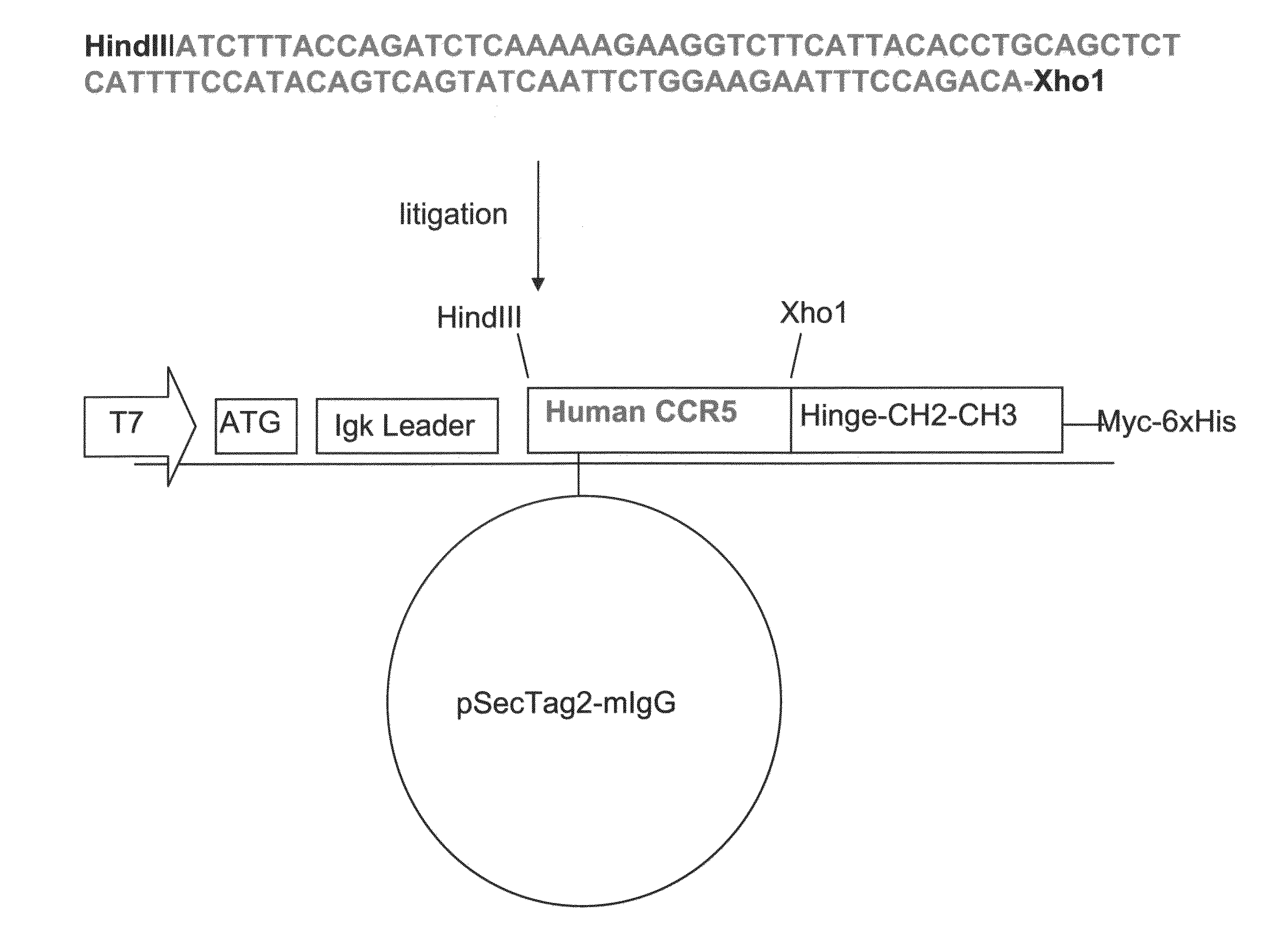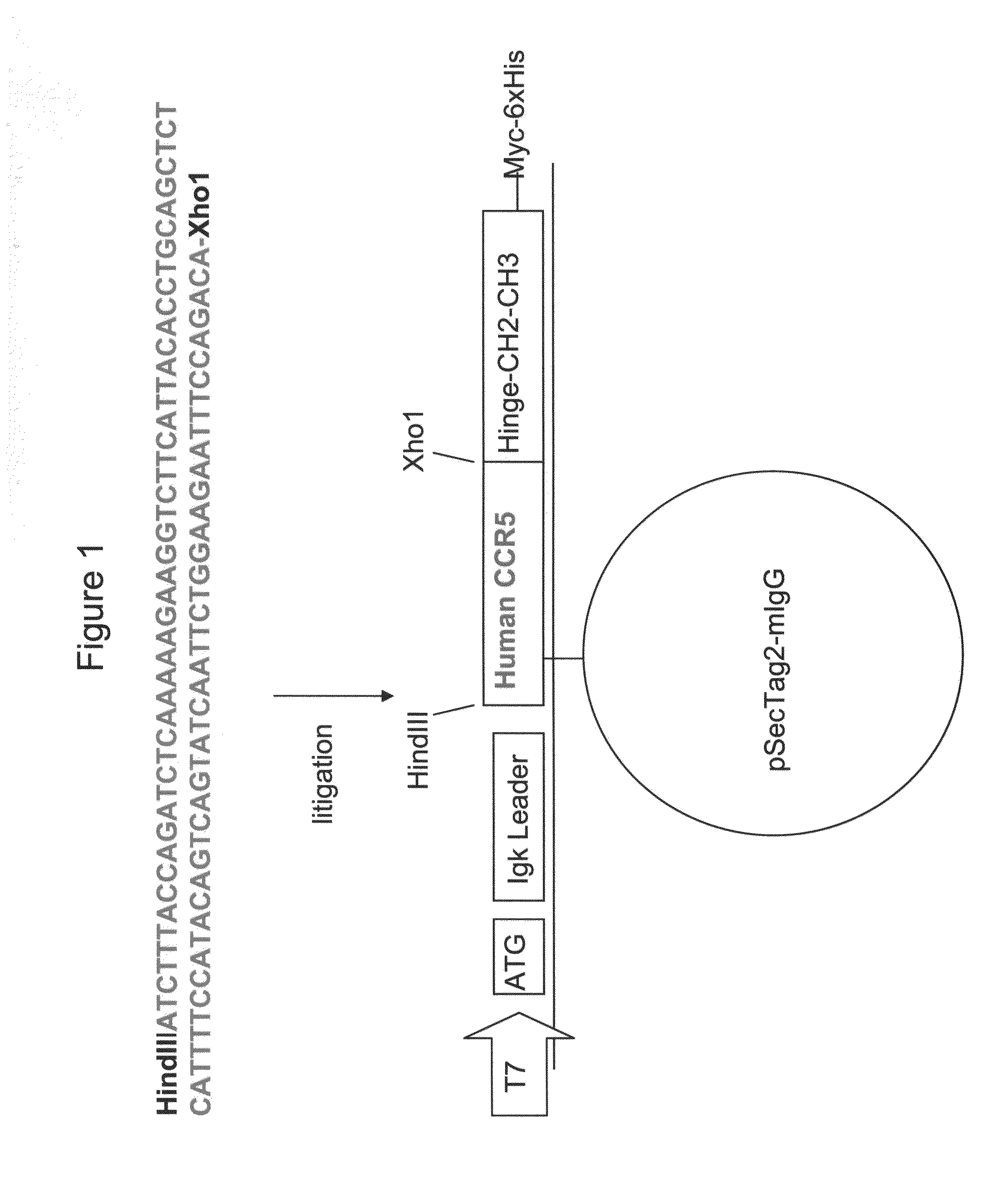Molecules and Methods of Using Same for Treating CCR5/CCR5 Ligands Associated Diseases
a technology of ligands and molecules, applied in the field of molecules and methods of treating ccr5/ccr5ligands associated diseases, can solve the problems of incompatibility with therapy, inability to construct whole soluble extracellular domains, and only membrane bound receptors,
- Summary
- Abstract
- Description
- Claims
- Application Information
AI Technical Summary
Benefits of technology
Problems solved by technology
Method used
Image
Examples
example 1
[0223]Generation of Recombinant Human and Murine CCR5-Fc Fusion Protein (CCR5-Ig) and Stable Expression in Cell Lines
[0224]Recombinant human (h) or murine (m) CCR5-Ig fusion proteins were produced for therapeutic use.
[0225]Materials and Experimental Procedures
[0226]Generation of Human CCR5-Ig Construct
[0227]Construction of the nucleic acid vector encoding the CCR5-Ig fusion protein of the present invention is schematically illustrated in FIG. 1. The IgG 1 construct was produced according to the basic protocol that was previously utilized for the generation of CTLA4-Ig [Van Oosterhout et al., Am J Respir Cell Mol Biol (1997) 17:386] with the following modifications: cDNA encoding the constant region (Hinge-CH2-CH3) of human IgG1 heavy chain has been cloned from LPS and IL-4 activated peripheral blood mononuclear cells (PBMC) onto pSecTag2 / Hygro B (Invitrogen, San Diego, Calif.). Human CCR5 (GenBank Accession No. NM—000579, SEQ ID NO: 33) was subcloned from LPS activated human PBMC us...
example 2
Binding Characteristics of the Different CCR5-IgG Extracellular Domains to CCR5 Ligands
[0234]The ability of EC1, EC2, EC3 and N domains of mCCR5-Ig to bind specifically to CCR5 natural ligands (CCL3, CCL4 and CCL5) was addressed by an ELISA assay.
[0235]Materials and Experimental Procedures
[0236]ELISA
[0237]The binding specificity of the different extracellular domains (EC1, EC2, EC3 and N) of the murine CCR5-IgG fusion proteins to various commercially available murine recombinant C≡C chemokines (R&D Systems, Minneapolis, N. Mex. including MIP-1α (CCL3), (CCL4) and RANTES (CCL5) was determined by direct ELISA as follows: 96-well ELISA plates (Nunc, Roskilde, Denmark) were coated with 10 ng / well of murine CCL3, CCL4 or CCR5 and blocked with 1% BSA in PBS. Wells were washed and incubated with 10 ng / ml, 100 ng / ml or 1000 ng / ml CCR5-IgG (EC1, EC2, EC3, N) at a concentration overnight. Wells were washed and the presence of CCR5-IgG was detected with goat anti mouse IgG-HRP (Jackson ImmunoR...
example 3
mCCR5(EC2)-IgG Selectively Binds CCL3, CCL4 and CCL5
[0240]The ability of the soluble receptor mCCR5(EC2)-IgG to bind different chemokines was addressed by an ELISA assay.
[0241]Materials and Experimental Procedures
[0242]ELISA
[0243]The binding specificity of the murine CCR5-IgG soluble receptor to various commercially available murine recombinant chemokines (R&D Systems, Minneapolis, N. Mex. including MIP-1α (CCL3), MIP-1β (CCL4), RANTES (CCL5), ITAC, MCP-1 (CCL2), CXCL16, MIG and IL-4 was determined by direct ELISA as follows: 96-well ELISA plates (Nunc, Roskilde, Denmark) were coated with 10 ng / well of murine CCL3, CCL4, CCL5, ITAC, MCP-1, CXCL16, MIG or IL-4 and blocked with 1% BSA in PBS. Wells were washed and incubated with 1 μg / well CCR5(EC2)-IgG overnight. Wells were washed and the presence of CCR5(EC2)-IgG was detected with goat anti mouse IgG-HRP (Jackson ImmunoResearch lot no. 58734). Results are shown as O.D. reading at 450 nm.
[0244]Results
[0245]Binding of mCCR5(EC2)-IgG to...
PUM
| Property | Measurement | Unit |
|---|---|---|
| concentrations | aaaaa | aaaaa |
| solubility | aaaaa | aaaaa |
| MW | aaaaa | aaaaa |
Abstract
Description
Claims
Application Information
 Login to View More
Login to View More - R&D
- Intellectual Property
- Life Sciences
- Materials
- Tech Scout
- Unparalleled Data Quality
- Higher Quality Content
- 60% Fewer Hallucinations
Browse by: Latest US Patents, China's latest patents, Technical Efficacy Thesaurus, Application Domain, Technology Topic, Popular Technical Reports.
© 2025 PatSnap. All rights reserved.Legal|Privacy policy|Modern Slavery Act Transparency Statement|Sitemap|About US| Contact US: help@patsnap.com



